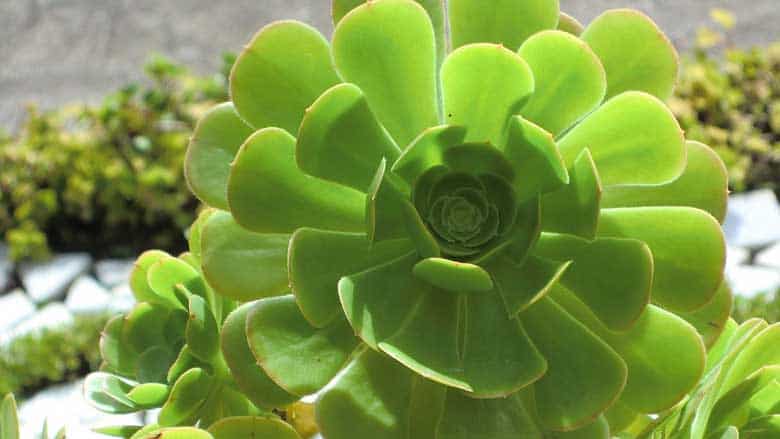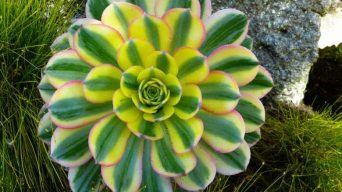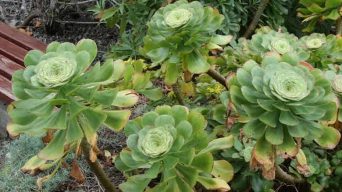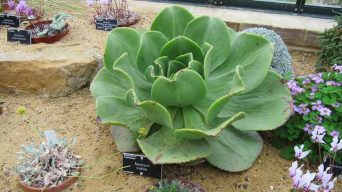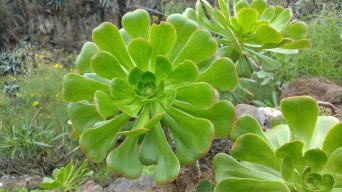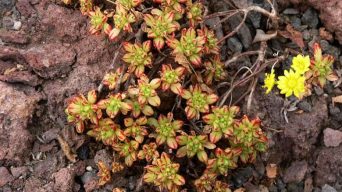The Aeonium urbicum (Saucer Plant) succulent plant is a beautiful addition to any garden or home.
But before you get an Aeonium urbicum, you must know how to take care of it and propagate the plant so that your succulent can have a long and healthy life in your green space!
This guide will cover everything you need to know about Aeonium urbicum care and propagation.
Overview
| Family: | Crassulaceae |
| Genus: | Aeonium |
| Botanical Name: | Aeonium urbicum |
| Synonyms: | Aeonium pseudourbicum, Sempervivum urbicum |
| Common Names: | Saucer Plant |
| Origin: | Tenerife in the Canary Islands |
| USDA Hardiness Zones: | 9b – 11b |
| Size: | 6.6 feet (2 m) tall, and rosettes up to 13 inches (32.5 cm) in diameter |
| Sun Exposure: | Full sun to partial shade |
| Water Needs: | Water thoroughly but infrequently |
| Soil Type: | Well-draining soil |
| Temperature: | 65 to 75˚F (18°-24˚C) during the day and 60˚F (16˚C) at night |
| Humidity Levels: | 40-50% |
The Aeonium urbicum succulent plant is a member of the Crassulaceae family and is native to Tenerife.
They exhibit a vertical growth pattern, characterized by a singular sizable rosette atop an unbranched stem that may reach a height of 6.6 feet (2 m). The rosette can attain a diameter of up to 13 inches (32.5 cm).
The Aeonium urbicum is usually called the ‘Saucer Plant’ because it has thick, bright green leaves that grow in a flat circular shape that covers a wide area like a saucer.
It has the characteristic that the tips of its leaves tend to turn red when the succulent is under stress.
This Aeonium plant produces hundreds of small, star-shaped, white-to-pink flowers on a 3 feet (90 cm) tall inflorescence during the summer.
How To Care for Aeonium Urbicum (Saucer Plant)
Aeonium urbicum care is very similar to Aeonium care in general.
Below are the main points to consider when caring for an Aeonium urbicum succulent.
Sun Exposure & Light Requirements
Aeonium urbicum plants need full sun to partial shade.
This Aeonium species are sun-loving succulents that need at least six hours a day without shade to thrive and grow well.
A perfect spot for these succulents is a place with morning sun and afternoon shade, preferably outdoors. Still, if not, a sunny window indoors will do just fine!
Watering Requirements
Aeonium urbicum plants need thorough watering approximately once a week.
They are succulents (they store water in their leaves), so they don’t need as much water.
It is best to allow the soil to dry completely before thoroughly watering.
The Saucer Plant needs to be watered in the morning if you live in an area with a lot of sun.
If you live in a cloudy area all day, they must be watered at night.
Soil Requirements
Aeonium urbicum plants do well with a soil mixture of sand, peat moss, and perlite to allow good drainage.
The top layer should contain a mix of one-third and two-thirds sand or fine gravel.
At the same time, the bottom third is more coarse material, such as cactus potting soil mixed in equal parts with generic garden loam (Top Layer: Sand/gravel; Bottom Layer: Garden loam).
What is essential is a mix of materials that will allow for good drainage.
The soil should be moist but not wet and soggy, leading to root rot in this Aeonium variety.
Temperature and Humidity
The Aeonium urbicum likes warm temperatures that usually range from 65° to 75° Fahrenheit (18°-24˚C) year-round, with nighttime lows not falling below 60° Fahrenheit (18°C).
It prefers humidity levels between 40% – 50%. A humidifier can be used if necessary; this should only happen once daily for four hours during dry periods.
If you live somewhere hot enough without needing a humidifier but still want one, it’s best to use a humidifier that is a cool mist or a vaporizer, not a warm mist.
Here are some tips for managing humidity in the home:
- Use a dehumidifier to remove excess moisture from your home’s air. The device will absorb water molecules in the air and store them inside a bucket on top of it until you need to empty it later.
- Open windows during dry periods can help increase airflow while also pulling dampness indoors due to higher atmospheric pressure levels. This may cause an overgrowth of mold, but this should be mitigated somewhat since fresh outdoor air will enter the room if you have a ventilator.
- Use a humidifier to increase humidity levels in your home and keep a constant flow of fresh air by opening windows. Use a dehumidifier or install a ventilator that moves hot indoor air outside while bringing cool outdoor air back into the house.
Fertilizing
The Aeonium urbicum does not need a lot of extra fertilizer. The occasional use of a diluted liquid fertilizer at about half-strength should be enough to keep this succulent healthy and green all year round.
When grown indoors, Aeonium urbicum plants should be fertilized at least once a year during the growing season.
Outdoor Aeonium succulents will generally not need fertilizer. Still, a diluted liquid fertilizer a couple of times a year will replenish any nutrients leached out by the rain.
Potting and Repotting
The Aeonium urbicum plant is best grown outdoors. This is a hardy plant that will not require a lot of care.
However, you may move your succulent into a pot if the weather becomes too dry or hot for it to survive outside.
To repot the Aeonium urbicum:
- The best time to repot an Aeonium urbicum in a container is when it has outgrown its current one and appears healthy and sturdy enough for the project.
- Potted plants should be transplanted during late fall, winter, or early spring. This period provides extended hours of sunlight while avoiding freezing temperatures.
- When transplanting the succulent into a new container, ensure at least one inch (about 25 mm) between the bottom edge of the root ball on top of the soil level.
- Don’t disturb the roots; use potting soil that drains well.
- Make sure there is a hole in the bottom of your container big enough for water to drain out freely. Otherwise, it may end up sitting stagnant through winter, killing your plant.
- Water thoroughly after transplanting.
Pruning
Aeonium urbicum only needs a light trimming a couple of times a year.
You will want to trim any dead leaves or flowers as they wither to keep your Aeonium urbicum healthy.
You may also need to remove older leaves if they look battered by environmental factors such as frost or drought.
These plants grow slowly, so regularly removing old growth is necessary to survive and thrive.
Pruning Aeonium urbicum is a delicate process because these plants are slow-growing. Any harsh cutting could cause them to stop growing for a while as they recover from the trauma of being cut back too hard.
Pests and Diseases
Aeonium urbicum is a succulent plant susceptible to a few pests.
The most common pests of Aeoniums are mealybugs, aphids, and whiteflies.
These pests usually live in the plant’s leaves, where they feed on sap and excrete a sticky substance that clogs leaf pores.
The best way to get rid of these bugs is by spraying them with a strong spray from a garden hose or other water source.
If Aeonium succulent plants are overwatered, fungal diseases may also become an issue.
You can control fungal diseases by reducing watering frequency and increasing air circulation around the roots in dry climates.
You should avoid excess water and a humid environment.
How to Care for Aeonium Urbicum in Winter
Aeonium urbicum winter care is a bit different than in the summer months.
The Aeonium urbicum is not a cold-hardy plant and will need a warm winter climate to survive.
The plant is sensitive to frost, breaking its leaves off and causing them not to regrow in the spring.
Aeoniums cannot withstand temperatures below 15-16 degrees Fahrenheit (- nine Celsius).
When temperatures are that low, you should withhold water from the succulent plants until they reach a more suitable temperature for growth again.
This will help prevent root rot or other fungal diseases from occurring due to too much moisture around roots in dry climates during the winter when air circulation is poor.
How To Propagate Aeonium Urbicum (Saucer Plant)
The Aeonium urbicum are easy to propagate succulents. They can be propagated by stem cuttings, leaves, or offsets.
Stem Cuttings
Aeonium urbicum can be propagated by a small piece of a stem.
You should take a small Aeonium stem cutting from a healthy plant, usually a diameter of about half an inch or more.
The cuttings should be allowed to callous for a few days before planting in well-draining soil.
The cuttings will produce a new plant very quickly. You can propagate them with more stem cuttings to create a continuous supply of aeoniums for your garden.
This is also an excellent way to propagate an Aeonium that has lost its leaves or been damaged in some other way, such as from frost or insect damage.
Leaves
Aeonium urbicum plants can be propagated by leaf cuttings.
To propagate the Aeonium urbicum succulent plant, you must carefully remove one leaf from a healthy mother plant.
Allow the cut end of the succulent to callous for about a few days before planting it in well-draining soil.
The leaves are much less sensitive than stem cutting. They need not wait as long after being cut before replanting them into good quality potting mix or garden soil.
They should be watered regularly but sparingly until they have rooted and started to establish themselves again.
Then water more liberally so there is no chance of drying out while waiting for established roots to provide moisture.
Offsets
The Aeonium urbicum produces offsets or pups.
A relatively mature Aeonium will produce an offset once a year, with growth rates varying according to climate and temperature.
Offsets should be separated from the mother plant when a pup is 12-14 inches tall.
To separate a pup, carefully remove it with a sharp knife or pruning shears. Keep as many of the roots on the offset intact as possible.
The offset should be planted in well-drained soil and watered frequently.
The offset will develop a root system on its own, and it should be able to support itself in a few months.
Is the Aeonium Urbicum Toxic?
The Aeonium urbicum can be toxic to humans and animals.
Always wear gloves while handling this succulent, and do not allow children or pets near aeonium urbicum plants.
Final Thoughts
The Saucer Plant is an excellent addition to any garden or home.
The Aeonium urbicum is an excellent beginner plant as they are easy to care for and propagate, so anyone can get one!

